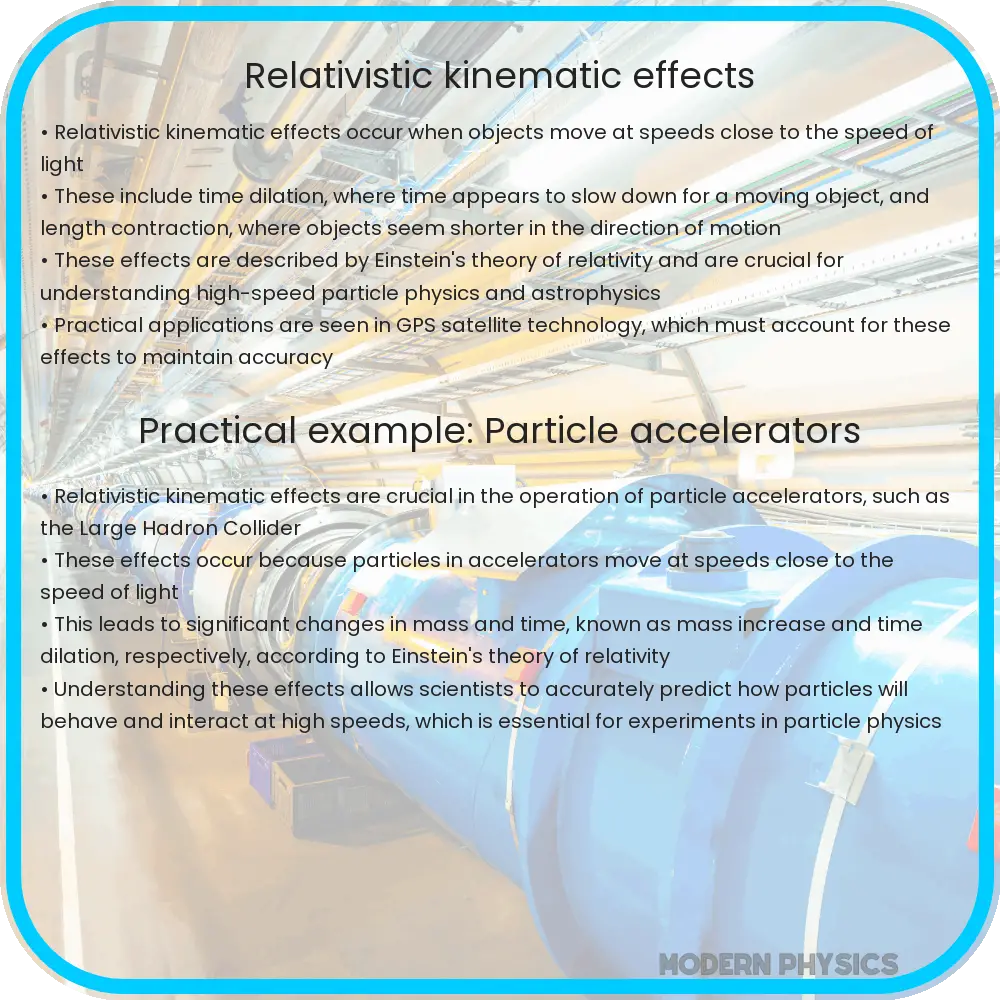Introduction to relativistic kinematic effects such as speed, time dilation, and mass, in the context of Einstein’s theory of relativity as objects approach light speed.

Relativistic Kinematic Effects: Speed, Time Dilation & Mass
In physics, the effects of relativity become significant when objects move at speeds close to the speed of light. These effects, described by Einstein’s theory of relativity, change our traditional understanding of speed, time, and mass. This article will introduce you to the fascinating concepts of relativistic kinematic effects: speed, time dilation, and mass.
Speed and Relativity
When we talk about speed in everyday life, we usually mean the distance traveled per unit of time, like kilometers per hour or miles per hour. However, when objects move very fast—approaching the speed of light (around 299,792 kilometers per second)—classical mechanics no longer applies. Instead, we must use the principles of special relativity.
According to special relativity, the speed of light c is the ultimate speed limit in the universe. No object with mass can reach or exceed this speed. As an object’s speed approaches the speed of light, its relativistic effects become more pronounced.
Time Dilation
Time dilation is one of the most intriguing effects of relativity. According to special relativity, time passes differently for observers in different frames of reference. This means that if you’re moving very fast, time will appear to pass more slowly for you compared to someone who is stationary.
- Formula: The mathematical representation of time dilation is given by
\( \Delta t’ = \frac{\Delta t}{\sqrt{1 – \frac{v^2}{c^2}}} \) - Here, \( \Delta t’ \) is the time interval measured by the moving observer.
- \( \Delta t \) is the time interval measured by the stationary observer.
- v is the relative velocity between the observers.
- c is the speed of light.
This formula reveals that as the relative velocity v approaches the speed of light, the term \( \sqrt{1 – \frac{v^2}{c^2}} \) approaches zero, making \( \Delta t’ \) much larger than \( \Delta t \). Thus, the faster you move, the more slowly time appears to pass for you.
Relativistic Mass
In addition to time dilation, objects also experience changes in mass when moving at relativistic speeds. Newtonian mechanics tells us that mass is a constant property of an object. However, relativity introduces the concept of relativistic mass, which increases with speed.
- Formula: The relativistic mass \( m_{rel} \) is given by
\( m_{rel} = \frac{m}{\sqrt{1 – \frac{v^2}{c^2}}} \) - Here, \( m \) is the rest mass of the object (mass when the object is stationary).
- v is the speed of the object.
- c is the speed of light.
As the object’s speed v approaches the speed of light, the denominator \( \sqrt{1 – \frac{v^2}{c^2}} \) approaches zero, causing the relativistic mass \( m_{rel} \) to increase significantly. This implies that as an object moves faster, it becomes harder to accelerate further, because its effective mass increases.
Real-World Applications and Implications
The principles of special relativity may seem abstract, but they have practical implications and real-world applications that affect various technologies and scientific endeavors.
- Global Positioning System (GPS): The satellites that enable GPS are moving at high speeds relative to the Earth’s surface and are also situated in weaker gravitational fields. Both special and general relativity must be accounted for to ensure the accuracy of the timing signals they use. Without correcting for time dilation effects, GPS would quickly become inaccurate.
- Particle Accelerators: In particle accelerators like the Large Hadron Collider (LHC), particles are accelerated to speeds very close to the speed of light. The increase in relativistic mass and necessary adjustments in calculations are crucial for understanding the behavior of these high-speed particles and conducting experiments in particle physics.
Conclusion
Relativistic effects profoundly alter our understanding of speed, time, and mass when objects approach the speed of light. Special relativity tells us that time slows down for fast-moving observers, mass increases with speed, and no object with mass can reach the speed of light. These insights not only reshape our theoretical framework but also have tangible applications in modern technology, such as GPS and particle accelerators.
By exploring these concepts, we gain a deeper appreciation of the universe’s complexities and the elegance of physical laws. As technology advances, the principles of relativity will continue to underpin significant innovations and enhance our understanding of the cosmos. So, the next time you use GPS or hear about particle accelerator experiments, you’ll know that relativistic effects are at work, guiding and informing those technologies.
